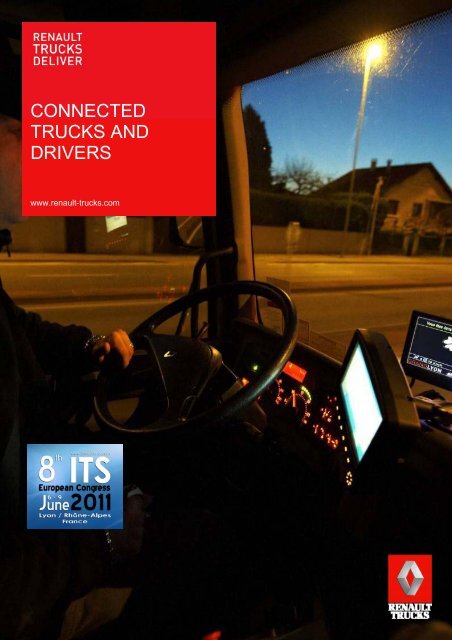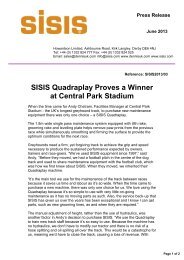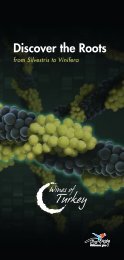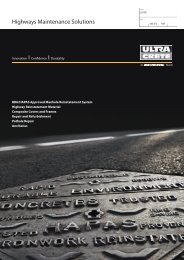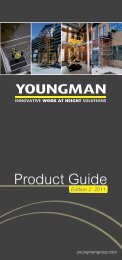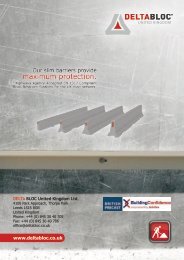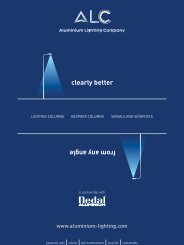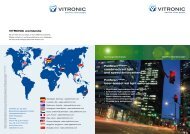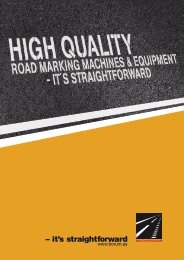Connecting truck and driver - Brintex
Connecting truck and driver - Brintex
Connecting truck and driver - Brintex
You also want an ePaper? Increase the reach of your titles
YUMPU automatically turns print PDFs into web optimized ePapers that Google loves.
CONNECTED<br />
TRUCKS AND<br />
DRIVERS<br />
www.renault-<strong>truck</strong>s.com
RENAULT TRUCKS<br />
Without <strong>truck</strong>s, everything would grind to a halt. As a designer, manufacturer <strong>and</strong> distributor of commercial<br />
vehicles Renault Trucks uses "intelligent" technologies to enhance hauliers' productivity together with meeting<br />
the interests of society. However, the manufacturer cannot imagine creating any transport system that is not<br />
built around people.<br />
People at the heart of a cooperative transport system<br />
Commercial vehicles are becoming increasingly incorporated into a complex system made up of components<br />
that interact with each other, exchanging information to optimise their assignments. Drivers <strong>and</strong> their <strong>truck</strong>s<br />
have become key links in the system, using telematics to obtain information which allows decision-makers to<br />
act in the best interests of safety, environmental protection <strong>and</strong> optimised mobility.<br />
<strong>Connecting</strong> <strong>truck</strong> <strong>and</strong> <strong>driver</strong><br />
In this context, the challenge is to simplify <strong>truck</strong> <strong>driver</strong>s' lives <strong>and</strong> help them with their assignments without<br />
taking away any of their responsibility. For they should always be in full comm<strong>and</strong> of their vehicle <strong>and</strong> its<br />
assistance systems, whether they are on-board or remote. The aim is to give <strong>driver</strong>s the key information they<br />
need in real time, allowing them to make the best choices <strong>and</strong> enjoy working <strong>and</strong> living in their cabs.<br />
Driver interconnection has reached a new level, since it is now possible for them to be directly linked to<br />
information systems via roaming applications designed to optimise their assignments. For example, since the<br />
beginning of 2011, Renault Trucks has been offering the NAV'TRUCK application, the first HGV dedicated<br />
GPS available for Smartphones. This application comes with a geo-locator so that users can contact the<br />
closest Renault Trucks service point with just two clicks. Other complementary applications will be regularly<br />
added to this system.<br />
ITS are the key to Green urban deliveries<br />
Renault Trucks believes that in the future, goods transport will be progressively separated into two distinct,<br />
although interrelated, types. On one h<strong>and</strong> there will be long haul transport carried out by highly productive rigs<br />
running on Diesel, <strong>and</strong> on the other, strictly regulated urban zones in which "grouped goods transport" will be<br />
provided by vehicles with high environmental credentials carrying consolidated loads.<br />
All-electric or electric-hybrid vehicles, such as the Renault Maxity electric or the Renault Premium Hybrys-Tech<br />
are now appearing on the European market. They are the first in the new generations of vehicles capable of<br />
meeting the dem<strong>and</strong>s of local public policies which will control the mobility of goods in urban environments <strong>and</strong><br />
impose "carbon free" transport solutions by limiting access in terms of space or time. They are also<br />
emblematic of the role Intelligent Transport Systems will have to play to guarantee that this mobility can be<br />
provided as energy-efficiently as possible <strong>and</strong> with a minimum level of nuisance.<br />
Their connection to the transport system is in fact essential, since the quantity of electrical energy stored on<br />
these vehicles is limited. This means <strong>driver</strong>s must always be sure they can replenish their energy supply. Their<br />
vehicle must therefore be able to receive information in real-time, processing <strong>and</strong> forwarding it in order to<br />
complete their assignments. This involves knowing the shortest or least congested route, the availability of<br />
delivery bays, conditions of access to protected zones, the location of supply sites, etc.<br />
Full-scale demonstrations<br />
For several years, Renault Trucks has been taking part in national <strong>and</strong> European research programmes<br />
demonstrating in the field how ITS technologies can contribute to incorporating commercial vehicles into<br />
transport systems. These include: CHAUFFEUR2, SafeTunnel, VIF, SafeSpot, CVIS, FIDEUS, CityLog, etc.<br />
This type of project makes it possible to test these technologies <strong>and</strong> determine what is involved <strong>and</strong> the<br />
benefits they can bring (safer, more productive, <strong>and</strong> more reliable operations having a reduced impact on the<br />
8th ITS European congress- Lyon<br />
CONNECTED TRUCKS AND DRIVERS 3/24<br />
June 2011
environment). They also highlight the necessity for a far-reaching collaborative effort between those concerned<br />
by the success of their implementation (infrastructure designers <strong>and</strong> managers, vehicle <strong>and</strong> equipment<br />
manufacturers, hauliers, public authorities, etc.).<br />
In particular, Renault Trucks is involved in the European FREILOT project which aims to improve the energy<br />
efficiency of urban deliveries by the use of ITS. Within the framework of this project, in 2011 Renault Trucks<br />
vehicles are taking part in a full-scale experiment in the Greater Lyon Authority area. They are fitted with<br />
automatic speed <strong>and</strong> acceleration limiters which are activated within certain predefined zones as well as realtime<br />
economic driving assistance to reduce their Diesel consumption <strong>and</strong> resulting CO2 emissions. With the<br />
same end in view, they will also support applications designed to give <strong>truck</strong>s priority at traffic lights.<br />
As an acknowledged specialist in urban vehicles <strong>and</strong> focusing its superior competences in this field in the<br />
Rhône-Alpes region, Renault Trucks is a founding member of the Lyon Urban Truck & Bus competitive cluster<br />
dedicated to public transport <strong>and</strong> grouped goods transport in urban areas. The company has the benefit of<br />
belonging to a powerful group (Volvo AB), particularly with respect to Volvo Technology (VTEC),<br />
which combines the skills of 500 researchers worldwide, all focusing on innovation in the vehicles, services<br />
<strong>and</strong> transport solutions field.<br />
8th ITS European congress- Lyon<br />
CONNECTED TRUCKS AND DRIVERS 4/24<br />
June 2011
NAV'TRUCK<br />
The first GPS for HGVs on smartphones<br />
At the beginning of 2011, Renault Trucks launched Nav'Truck, the first GPS<br />
application specially designed for HGVs, available on iPhone <strong>and</strong> Android.<br />
Once <strong>driver</strong>s have entered their vehicle's configuration into the system, they<br />
will be given a route entirely made up of the safest roads <strong>and</strong> those they are<br />
allowed to take. A series of add-on applications to further facilitate their<br />
transport assignment is also available.<br />
Advantages<br />
<br />
Maps accurate routes<br />
■ Increases productivity<br />
■ Reduces delivery times<br />
■ Reduces<br />
the risk of error<br />
Information on access restrictions<br />
■ Increases safety<br />
■ Reduces<br />
costs<br />
Main functions<br />
<br />
<br />
Products & services<br />
■ Enables low bridges <strong>and</strong> restricted access roads to be avoided<br />
■ Gives warnings of hairpin bends or no-overtaking zones<br />
■ Enables HGV prohibited bends <strong>and</strong> U-turn zones to be avoided<br />
■ Enables roads prohibited to dangerous or inflammable materials to be avoided<br />
■ Vocal instructions at each corner using "Text<br />
to speech" technology to announce street<br />
names<br />
■ 3-D <strong>and</strong> 2-D driving views with variable zoom<br />
■ Positioning indicator on the road giving a more realistic view at complex intersections<br />
■ Street number navigation accuracy or to a contact address<br />
■ St<strong>and</strong>ard radar warnings<br />
■ Adjustable speed limitation warnings (speed limitation warnings<br />
for HGVs only available in<br />
some zones)<br />
■ Routes with multiple stopping points <strong>and</strong> road plans<br />
Smartphone integration<br />
■ Navigation continues during calls<br />
■ Calls or navigation<br />
to points of interest by touching the screen<br />
■ Portrait or L<strong>and</strong>scape<br />
mode with "Pinch to zoom"<br />
Live services<br />
■ Live Local Search<br />
■ Live weather: with 5 day forecasts.<br />
■ Live Traffic Warnings<br />
8th ITS European congress- Lyon<br />
CONNECTED TRUCKS AND DRIVERS 5/24<br />
June 2011
Complementary applications (1 per month)<br />
Renault<br />
Trucks network<br />
■ Indicates the closest<br />
Renault Trucks network outlet <strong>and</strong> the services it offers. Once located,<br />
the <strong>driver</strong> can contact the dealer by telephone or visit the dealership website <strong>and</strong> then view<br />
the shortest route for reaching<br />
it. The application is available in French <strong>and</strong> English <strong>and</strong> lists<br />
more than 1,500 Renault Trucks service points in the 100 countries where the manufacturer<br />
is represented.<br />
Deliver<br />
eye<br />
■ In the event of any incident,<br />
<strong>driver</strong>s can take a photograph of the situation on which the time,<br />
date <strong>and</strong> place are shown. This can then<br />
be sent into the office as proof of what has been<br />
reported.<br />
Renault Trucks Racing<br />
■ The <strong>truck</strong> racing simulation videogame.<br />
Technical<br />
description<br />
<br />
Partners<br />
NAVTEQ Transport Q3 2010 data<br />
■ Detailed maps with restrictions for HGVs:<br />
Austria, Belgium, Croatia*, the Czech Republic*, Denmark, Germany, Finl<strong>and</strong>*, France,<br />
Hungary*, Irel<strong>and</strong>*, Italy*, Luxembourg, the Netherl<strong>and</strong>s, Norway*, Pol<strong>and</strong>*, Slovakia*, Slovenia*,<br />
Spain,<br />
Sweden*,<br />
Switzerl<strong>and</strong>, the United Kingdom.<br />
■ Detailed maps without restrictions for HGVs:<br />
Andorra,<br />
Estonia, Gibraltar, Greece, Latvia, Liechtenstein, Lithuania, Monaco, Saint Marino,<br />
Vatican<br />
City.<br />
■ Main<br />
roads <strong>and</strong> towns<br />
Albania, Bosnia <strong>and</strong> Herzegovina, Byelorussia,<br />
Bulgaria, Macedonia, Moldavia, Montenegro,<br />
Romania, Russia, Serbia, Ukraine.<br />
■ ALK Technologies: development<br />
■ NAVTEQ: european<br />
cartography<br />
Distribution<br />
■ AppStore<br />
■ Android Market<br />
8th ITS European congress- Lyon<br />
CONNECTED TRUCKS AND DRIVERS 6/24<br />
June 2011<br />
*HGV restrictions on main roads only
ELECTRIC MAXITY<br />
Full electric light commercial vehicle<br />
Specifically designed for operating in town centres on specific urban<br />
applications, the Electric Maxity opens up new horizons for fleet<br />
managers. With its zero emission <strong>and</strong> zero noise pollution, this LCV is<br />
perfectly adapted to access to protected <strong>and</strong> restricted access zones by<br />
day <strong>and</strong> by night without infringing any regulations. It has a payload<br />
capacity of up to 1.5 t <strong>and</strong> can be driven, in France, with a car driving<br />
licence, just like any other LCV with a GVW of less than 3.5 t<br />
Products & services<br />
Fitted with an asynchronous electric motor requiring very little maintenance compared with a comparable<br />
internal combustion engine, the Electric Maxity is powered by latest generation Li-ion batteries which can be<br />
recharged in 7 hours. The recovery of braking energy <strong>and</strong> speed limited to 70 km/h for urban applications<br />
gives the Electric Maxity an average operating range of 100 km <strong>and</strong> an instant maximum torque. For greater<br />
driving comfort <strong>and</strong> improved manoeuvrability, the Electric Maxity is equipped with a robotised gearbox, <strong>and</strong><br />
features a turning radius of only 6.74 m.<br />
Application<br />
■ Urban distribution <strong>and</strong> other activities geared for the urban environment (garden<br />
maintenance, street furniture maintenance <strong>and</strong> waste collection)<br />
Advantages<br />
<br />
■ No pollutant emissions in the atmosphere<br />
■ No CO2 emissions<br />
■ No noise pollution<br />
■ Quiet night-time operation<br />
■ Access to low emission zones<br />
■ Braking energy regeneration to recharge batteries<br />
Original chassis<br />
■ 4500 kg technical GVW<br />
■ Homologated at 3500 kg in France, thanks<br />
to a specific regulation for "clean vehicles“ (car<br />
driving license)<br />
■ Payload from 1.1T up to 2T in France<br />
Electri c driveline<br />
■ Up to 100 km average operating range<br />
■ 90 km/h max speed (limited at 70 km/h)<br />
■ 6 speed robotized gearbox<br />
■ 47 kW asynchronous electric motor<br />
controlled by flux vector variation<br />
■ Instant maximum torque (270 Nm)<br />
■ Brake<br />
energy regeneration<br />
■ Electrically-operated<br />
ancillaries<br />
Batteries ■ 40 kWh batteries (~weight 400 kg). Li-ion technology<br />
■ Battery charge time: 7 hours<br />
8th ITS European congress- Lyon<br />
CONNECTED TRUCKS AND DRIVERS 7/24<br />
June 2011
PREMIUM HYBRYS TECH<br />
Fuel efficient, quiet <strong>and</strong> clean<br />
Leading the field with experimentation of hybrid technology in Europe<br />
since 2009, Renault Trucks has been able to test several Renault<br />
Premium Distribution Hybrys Tech vehicles under actual operating<br />
conditions. The manufacturer achieves this aim by supplying selected<br />
customers with hybrid vehicles so that they can try out this technology in<br />
an urban context for as wide a range of applications as possible.<br />
Field tests<br />
Products & services<br />
Waste collection. In 2008 <strong>and</strong> 2009 Renault Trucks <strong>and</strong> its partners, the Greater Lyon Authority<br />
<strong>and</strong> SITA (the environmental branch of the Suez Group), tested a hybrid refuse collection vehicle<br />
in the Lyon conurbation.<br />
Supply of urban worksite. Colas a subsidiary of the Bouygues Group is testing a vehicle fitted<br />
with a tipper body dedicated to supplying urban worksites with bulk materials in the Lyon<br />
conurbation.<br />
Delivery. Coca-Cola Enterprises Belgium is operating a vehicle on the roads of the Brussels<br />
conurbation delivering the br<strong>and</strong>'s products to various outlets.<br />
Results<br />
<br />
<br />
■ Energy consumption cut by up to 20 % (up to -30% in household refuse collection<br />
configuration)<br />
■ Quieter operation: Diesel engine shuts down when vehicle is at a st<strong>and</strong>still <strong>and</strong> starts off in<br />
electric mode<br />
■ Improved vehicle mobility <strong>and</strong> driving comfort<br />
Advantages<br />
■<br />
■<br />
For the individual:<br />
• Lower CO2 emissions<br />
• Less noise (stopping, starting <strong>and</strong> collecting phases)<br />
• Lower local pollution<br />
(Electrical starts)<br />
For the community:<br />
• Reduced environmental impact<br />
• Lower diesel oil consumption<br />
• Operation over longer time periods<br />
(operating range)<br />
• Operation in low noise zones<br />
Implemented Technologies<br />
■<br />
■<br />
"Parallel" hybrid technology<br />
• Kinetic energy recovered in slowing down <strong>and</strong> braking phases.<br />
• Operating modes: all-electric; Diesel;<br />
Diesel-electric<br />
Diesel/Electrical Driveline :<br />
• DXi 7 Euro V Diesel engine<br />
• 1 MDS (Motor Drive System) electrical motor: 120 kW peak power <strong>and</strong> 70 kW continuous<br />
• 1 Opti<strong>driver</strong>+ robotized transmission<br />
• 1 ESS electric block (Electrical Storage System) in the wheelbase, including power<br />
batteries, control electronics, power distribution circuits, cooling system.<br />
8th ITS European congress- Lyon<br />
CONNECTED TRUCKS AND DRIVERS 8/24<br />
June 2011
FREILOT<br />
Urban Freight Energy Efficiency Pilot<br />
Objectives Research programmes<br />
To facilitate <strong>and</strong> stimulate market introduction<br />
of ICT services aiming at increasing energy<br />
efficiency ■ Showing quantifiable benefits to all relevant stakeholders.<br />
■ Ensuring that FREILOT implementations continue after the pilot.<br />
■ Extending<br />
the implementations to more cities <strong>and</strong>/or <strong>truck</strong> fleets.<br />
Increasing<br />
fuel prices <strong>and</strong> effects from climate changes have brought the increase of energy efficiency to the<br />
forefront in all aspects of life. Considering Transport, the European Commission has identified it as one of the<br />
areas where the biggest energy savings are to be made: 27% by 2020.<br />
FREILOT pilot focuses on reducing energy<br />
consumption of goods delivery vehicles in urban areas. The<br />
specific<br />
energy consumption of urban goods transport depends on many factors; vehicle performance, <strong>driver</strong><br />
behaviour, urban geography <strong>and</strong> the road network, traffic control strategies <strong>and</strong> performance,<br />
weight of the<br />
vehicle<br />
<strong>and</strong> its load to name but a few.<br />
Pilot locations : Helmond, Netherl<strong>and</strong>s<br />
; Lyon, France ; Bilbao, Spain ; Krakow, Pol<strong>and</strong>.<br />
<br />
■ Demonstrate -25% CO emissions<br />
2<br />
Description<br />
Services<br />
Energy efficiency optimised<br />
intersection control<br />
Real-time<br />
delivery space booking<br />
Acceleration<br />
limiter <strong>and</strong> Adaptive speed limiter<br />
Eco driving support<br />
8th ITS European congress- Lyon<br />
CONNECTED TRUCKS AND DRIVERS 9/24<br />
June 2011
Expected impacts <strong>and</strong> benefits<br />
■ Reduced fuel consumption<br />
■ Reduced CO emissions<br />
2<br />
■ Reduced number of vehicle stops <strong>and</strong> go<br />
■ Adapted <strong>driver</strong>/vehicle behaviour<br />
■ Better speed adaptation<br />
Evaluation of mature systems & services<br />
through real condition usage<br />
■ Systems validation <strong>and</strong><br />
tuning<br />
■ Driver acceptance<br />
■ Energy consumption analyses<br />
Stimulate market introduction of such services<br />
<br />
Partners Partnership with key partners as public authorities, laboratories <strong>and</strong> fleet operators<br />
■ ERTICO ITS-EUROPE (coordinator)<br />
■ PEEK Traffic<br />
■ MLC-ITS EUSKADI<br />
■ Renault Trucks<br />
■ Volvo Technology<br />
■ CTAG (Fundación para la promoción de la innovación, investigación<br />
y desarrollo tecnológico<br />
de la industria de automoción de Galicia)<br />
■ CERTH (Centre For Research <strong>and</strong> Technology<br />
HELLAS)<br />
■ CNRS-LET (Centre National de la Recherche Scientifique)<br />
■ City of Helmond<br />
(Gemeente Helmond)<br />
■ City of Bilbao (Ayuntamiento<br />
de Bilbao)<br />
■ Gr<strong>and</strong> Lyon (Communauté<br />
urbaine de Lyon)<br />
■ City of Lyon<br />
■ Van den Broek<br />
Logistics<br />
■ Transportes AZKAR<br />
■ Thetis<br />
■ POLIS (Promotion of Operational Links with Integrated Services)<br />
■ GERTEK<br />
■ Transportes NANUK<br />
■ UL2-LET (Université Lumière<br />
Lyon 2 - Laboratoire d’Économie des Transports).<br />
Funding programme<br />
Duration<br />
■ European Commission.<br />
■ Project approved by the Lyon Urban Truck & Bus cluster.<br />
■ 3 years (2009-2012).<br />
8th ITS European congress- Lyon<br />
CONNECTED TRUCKS AND DRIVERS 10/24<br />
June 2011
CVIS <strong>and</strong> SAFESPOT<br />
Renault Premium Distribution Demonstrator<br />
Objectives<br />
<br />
CVIS: Increase efficiency <strong>and</strong> safety through V2V <strong>and</strong> V2I cooperation enabled by:<br />
■ An open architecture <strong>and</strong> a universal platform prototype<br />
■ A wireless network amongst vehicles & infrastructure<br />
■ A framework for application management<br />
■ Enhanced positioning <strong>and</strong> mapping solutions<br />
■ Cooperative data management <strong>and</strong> exchange<br />
■ Innovative cooperative applications<br />
Research programmes<br />
SAFESPOT: Increase road safety through<br />
“intelligent” vehicles <strong>and</strong> “intelligent” infrastructures<br />
cooperation by<br />
developing/assessing:<br />
■ Wireless communication amongst vehicles <strong>and</strong> infrastructure<br />
■ Collection <strong>and</strong> transmission<br />
of dynamic parameters <strong>and</strong> safety information in real-time<br />
■ High precision geo-positioning Innovative cooperative applications<br />
■ Local Dynamic<br />
Maps<br />
Description<br />
Experimental platform<br />
Renault Premium Distribution for new solutions developed by Volvo<br />
Technology within the European Research Programs framework on mobility (CVIS) <strong>and</strong> safety<br />
(SAFESPOT.)<br />
8th ITS European congress- Lyon<br />
CONNECTED TRUCKS AND DRIVERS 11/24<br />
June 2011
Applications<br />
CVIS<br />
■ Pre-reservation of delivery spaces or parking<br />
■ Access control (Authorization access to sensitive, low-emission areas according to the<br />
characteristics of the vehicle)<br />
■ Supply of information on the traffic <strong>and</strong> route advice<br />
■ Speed <strong>and</strong> environmental instructions<br />
■ Intersections instructions<br />
Possible advantages<br />
■ Reduction of delivery delays<br />
■ Reduction of the polluting <strong>and</strong> C02 emissions<br />
■ Traffic fluidity<br />
■ Driver comfort <strong>and</strong> safety improved<br />
SAFESPOT<br />
■ Information of road conditions<br />
■ Speeds limitation <strong>and</strong> safety distance warning<br />
■ Lane-change assistance<br />
■ Frontal <strong>and</strong> head-on collision warning<br />
■ Ghost <strong>driver</strong> Detection<br />
■ Intersections instructions<br />
■ Detection <strong>and</strong> protection of the vulnerable<br />
road users<br />
■ Local Dynamic Map<br />
Possible advantages<br />
■ Reduction of the number of accidents<br />
■ Traffic fluidity<br />
8th ITS European congress- Lyon<br />
CONNECTED TRUCKS AND DRIVERS 12/24<br />
June 2011
Results<br />
Contribution to E.U. Directive on intelligent transport<br />
systems deployment<br />
Agreed priority areas<br />
■ Optimal use of road, traffic <strong>and</strong> travel data;<br />
■ Continuity of traffic <strong>and</strong> freight management ITS services;<br />
■ ITS road safety <strong>and</strong> security applications;<br />
■ Linking the vehicle with<br />
the transport infrastructure<br />
CVIS <strong>and</strong> SAFESPOT developed cooperative platforms <strong>and</strong> applications that demonstrated how intelligent<br />
vehicles on intelligent roads can improve<br />
network efficiency <strong>and</strong> safety. Projects outcomes are being used in<br />
several follow-up initiatives, e.g european projects FREILOT, eCoMove <strong>and</strong> COSMO. Both projects took an<br />
active part in the st<strong>and</strong>ardization of the co-operative<br />
systems (architecture, communication protocols, <strong>and</strong><br />
messages)<br />
via ETSI <strong>and</strong> CEN.<br />
Funding programme<br />
Coordination Duration<br />
Agreed priority actions<br />
■ The provision of EU-wide multimodal travel information services;<br />
■ The provision of EU-wide real-time traffic<br />
information services;<br />
■ Data <strong>and</strong> procedures for the provision of road safety related minimum universal traffic<br />
information free of charge to users;<br />
■ The harmonised provision for an interoperable EU-wide eCall;<br />
■ The provision of information services for safe <strong>and</strong> secure parking places for <strong>truck</strong>s <strong>and</strong><br />
commercial vehicles;<br />
■ The provision of reservation services for safe <strong>and</strong> secure parking places for <strong>truck</strong>s <strong>and</strong><br />
commercial vehicles<br />
Partners (CVIS <strong>and</strong> Safespot)<br />
<br />
■<br />
European Community - FP6<br />
■ CVIS<br />
: ERTICO – ITS Europe<br />
■ SAFESPOT : Centro Ricerche Fiat<br />
■ CVIS/SAFESPOT: 2006–2010<br />
For further information: www.cvisproject.org ; www.safespot-eu.org<br />
8th ITS European congress- Lyon<br />
CONNECTED TRUCKS AND DRIVERS 13/24<br />
June 2011
CITYLOG<br />
Sustainability <strong>and</strong> efficiency of city logistics<br />
Objective<br />
Research programmes<br />
To contribute to the improvement of the overall city logistics efficiency through a combination of<br />
several measures:<br />
■ Technology<br />
Info-telematic support functionalities<br />
New logistic-oriented vehicle solutions<br />
■ Delivery process review<br />
Vehicle-to-vehicle transhipment<br />
Innovative <strong>and</strong> interoperable load units<br />
Global logistic scheme<br />
<br />
Logistic<br />
hub 1<br />
Freight bus<br />
route<br />
Today’s situation<br />
CityLog concept<br />
Proposed logistic model<br />
City<br />
centre<br />
Transhipment areas<br />
Delivery van route<br />
Delivery<br />
van<br />
route<br />
Today, commercial vehicles leave the hubs for the delivery missions.<br />
The paradigm is: one vehicle, one mission. In the CityLog vision, the<br />
freight will be moved from the hub to the city centre by a “freight bus”, a<br />
vehicle able to carry several load units. The load unit will then be<br />
transferred onto a van for the last mile delivery. These innovative,<br />
compact load units will have several configurations, also to be used<br />
according to the “Bento Box” concept, a sort of mobile pack station. The<br />
Ben to Box allows decoupling the parcel delivery by the carrier <strong>and</strong> the<br />
customer fetching his parcel in<br />
order to reduce unsuccessful deliveries.<br />
8th ITS European congress- Lyon<br />
CONNECTED TRUCKS AND DRIVERS 14/24<br />
June 2011<br />
At the transhipment area<br />
Today 3 vans leave the hub <strong>and</strong> enter the city<br />
for the final deliveries. In CityLog, a freight bus<br />
moves the containers downtown with the freight<br />
for 3 urban areas. Vans carry out the distribution:<br />
for each area they load the respective container.
Expected impacts <strong>and</strong> benefits<br />
Partners ■ Low environmental impact <strong>and</strong> safe vehicles<br />
■ Optimized routing for commercial vehicles, less impact on urban mobility<br />
■ Flexible solutions <strong>and</strong> higher efficiency of the freight distribution<br />
■ Reduction of unsuccessful deliveries<br />
■ Safety manoeuvring<br />
■ Closer to the stakeholders needs: operators, <strong>driver</strong>s, city authorities, end users<br />
■ Centro Ricerche FIAT (coordinator)<br />
■ IVECO<br />
■ Volvo Technology (Renault Trucks)<br />
■ TNT<br />
Express Italy<br />
■ NAVTEQ<br />
■ TNO<br />
■ PTV – Planung<br />
Transport Verkehr<br />
■ Mizar Automazione<br />
■ Fraunhofer Institut<br />
für<br />
Produktionsanlagen und Konstruktionstechnik<br />
■ Europlatforms<br />
■ Senatsverwaltung für Stadtentwicklung<br />
Berlin<br />
■ Communauté Urbaine de Lyon<br />
■ Regione Piemonte<br />
■ ERTICO-ITS EUROPE<br />
■ ICOOR – Interuniversity Consortium<br />
for Optimization<br />
<strong>and</strong> Operation Research<br />
■ Interface Transport<br />
■ RE:LAB<br />
■ Logistic Network Consultants.<br />
Funding<br />
program<br />
Duration ■ European Commission<br />
– FP7.<br />
■ Supported by EUCAR, the European Council for Automotive R&D.<br />
■ Project approved by the Lyon Urban<br />
Truck & Bus cluster.<br />
■ 3 years<br />
(2010-2012)<br />
For<br />
further information: www.city-log.eu<br />
8th ITS European congress- Lyon<br />
CONNECTED TRUCKS AND DRIVERS 15/24<br />
June 2011
COROLA<br />
COncrete mixer ROllover Avoidance<br />
Objective<br />
Research programmes<br />
The aim of COROLA is to provide the <strong>truck</strong> <strong>driver</strong> in advance with information regarding the rollover stability.<br />
Using GPS technology <strong>and</strong> tools, the <strong>truck</strong> is positioned (latitude <strong>and</strong> longitude) on a digital road via mapmatching<br />
algorithms. Then, we estimate the road curvature, calculate in real-time the suitable max speeds <strong>and</strong><br />
alert the <strong>driver</strong> if the speed profile of the <strong>truck</strong> is risky compared to a reference.<br />
Description<br />
<br />
<br />
■ Using GPS technology, the <strong>truck</strong> is positioned on a digital map <strong>and</strong> the road identified.<br />
■ The suitable max speeds are calculated in real-time from road curvatures.<br />
■ The <strong>driver</strong> is alerted (sound <strong>and</strong> visual) if his speed profile is risky compared to a reference.<br />
■ The feature is released in a st<strong>and</strong>alone device that can be retrofitted on all existing <strong>truck</strong>s.<br />
Expected impacts <strong>and</strong> benefits<br />
■ Driver’s safety.<br />
■ Accident avoidance.<br />
■ Overall road safety <strong>and</strong> service.<br />
Partners<br />
■ Renault Trucks (coordinator)<br />
■ Adeneo (Adetel Group) - Embedded Electronic hardware <strong>and</strong> software<br />
design company<br />
■ Lafarge - Concrete <strong>and</strong> gravels supply<br />
■ University of LYON I – LEACM/CRIS – Human science laboratory<br />
■ IFSTTAR (former INRETS) – French institute of science <strong>and</strong> technology for transport,<br />
development <strong>and</strong> networks.<br />
Funding program<br />
Duration<br />
■ FEDER.<br />
■ Project<br />
approved by the Lyon Urban Truck & Bus cluster.<br />
■ 3 years (2009-2011)<br />
8th ITS European congress- Lyon<br />
CONNECTED TRUCKS AND DRIVERS 16/24<br />
June 2011
FIDEUS<br />
Freight Innovative Delivery of goods in European Urban<br />
Spaces<br />
Objective<br />
Research programmes<br />
To test innovative urban freight delivery solutions on the basis of vehicles fitted with on-board ICT<br />
services enabling communication with the infrastructure.<br />
Renault Trucks developed a medium range (12-tonne) 190 hp Renault Midlum, equipped with new emissions<br />
reduction systems, better safety <strong>and</strong> security features, improved <strong>driver</strong> environment.<br />
It was tested in the Gr<strong>and</strong> Lyon area by DHL for parcels delivery in January 2008 <strong>and</strong> in Barcelona by Condis<br />
for night deliveries in March 2008.<br />
Results<br />
Lower noise emissions, down to –6 dB (A) for night-time deliveries<br />
■ Reduced impact by a work on noise generating sources<br />
■ Low noise mode through active driveline monitoring<br />
Fuel savings <strong>and</strong> lower air pollution<br />
■ Low emission <strong>and</strong> low consumption mode through active driveline monitoring.<br />
<br />
<br />
Improved safety<br />
■ H<strong>and</strong>s-free entry <strong>and</strong> exit<br />
■ Automatic <strong>driver</strong> identification<br />
■ Automatic door <strong>and</strong> window control<br />
Enhanced operational efficiency<br />
■ Navigation, geo-location, continuous contact with the control base, via PDA<br />
■ RFIS parcels identification<br />
■ Authorisation to access low emission zones<br />
8th ITS European congress- Lyon<br />
CONNECTED TRUCKS AND DRIVERS 17/24<br />
June 2011
Partners<br />
■ Renault Trucks<br />
■ IVECO<br />
■ Impacts<br />
■ Gr<strong>and</strong> Lyon<br />
■ Barcelona de Serveis Municipals, S.A.<br />
■ DHL<br />
■ TNT<br />
■ Dsd<br />
■ Mizar<br />
■ University of Westminster<br />
■ Centro Ricerche FIAT<br />
(coordinator)<br />
■ Cybernetics France<br />
■ Hannover region<br />
■ Impacts Europe<br />
Funding<br />
programme<br />
Duration<br />
■ European<br />
Commission - FP6<br />
■ 3 years (2006-2009)<br />
8th ITS European congress- Lyon<br />
CONNECTED TRUCKS AND DRIVERS 18/24<br />
June 2011
VIF<br />
Interactive Vehicle of the Future<br />
Objectives<br />
Definition, Implementation <strong>and</strong> assessment of a Vehicle-Infrastructure System<br />
■ To optimize costs of transport (infrastructures <strong>and</strong> vehicles)<br />
■ To improve safety on the<br />
roads<br />
■ To reduce congestion<br />
■ To reduce pollution<br />
Description<br />
<br />
<br />
<br />
Research programmes<br />
On board functions<br />
■ Speed limitation in a given geographical area<br />
■ Maintenance of a minimum distance between<br />
vehicles in a given geographical area (ACC)<br />
■ Rollover prediction<br />
■ Driver's information display management<br />
■ Axle load information improvement<br />
■ Fuel gauge information improvement<br />
■ Collection of legal<br />
data from digital tachograph<br />
■ Area management <strong>and</strong> communications<br />
with the control tower<br />
■ Weigh station<br />
Functions hosted in the Control Center<br />
■ Area management <strong>and</strong> communications with<br />
the<br />
vehicle<br />
■ Human-Machine Interface<br />
■ Collection<br />
of legal data from digital tachograph<br />
■ Forecast calculation of fuel consumption<br />
Results<br />
A complete system involving vehicle, in-motion weigh station <strong>and</strong> management center.<br />
Partners<br />
■ Renault Trucks (Coordinator)<br />
■ Michelin<br />
■ SODIT<br />
■ Actia Group<br />
■ LCPC – Laboratoire<br />
Central des Ponts et Chaussées.<br />
Funding programme<br />
Duration<br />
■ PREDIT/ FUI.<br />
■ Project approved by Lyon<br />
Urban Truck & Bus cluster (LUTB).<br />
■ 3 years (2005-2008)<br />
8th ITS European congress- Lyon<br />
CONNECTED TRUCKS AND DRIVERS 19/24<br />
June 2011
PROMOTE-CHAUFFEUR 2<br />
Objectives<br />
<br />
■ To help to assess the problems of <strong>truck</strong> integration into traffic<br />
■ Various <strong>truck</strong>s exchange data between them<br />
■ The infrastructure is used as the reference<br />
system.<br />
■ Sensors allow measuring environment<br />
■ Man-machine interfaces<br />
■ Communications protocols <strong>and</strong> technologies.<br />
Expectations <strong>and</strong> benefits<br />
<br />
Research programmes<br />
ACC: Adaptive Cruise Control<br />
■ As long as no vehicle is detected ahead, the ACC system provides speed control as a<br />
conventional Cruise Control system.<br />
■ If a vehicle is detected in the<br />
current lane, the ACC then provides a Safe Distance Control.<br />
Tow bar – Automated platoon<br />
■ Tow bar system provides an electronic coupling of two or more <strong>truck</strong>s in an automated<br />
platoon. Only the first <strong>truck</strong> needs an active <strong>driver</strong>.<br />
■ The Tow bar features a very short following distance control: about 12 meters at 90kmh.<br />
Therefore, a 2-<strong>truck</strong> Tow bar platoon is about 45% shorter than 2 conventional <strong>truck</strong>s<br />
separated by the legal distance of 50 m. The aerodynamic drag is reduced as well, <strong>and</strong> the<br />
fuel consumption of the so-formed convoy is lowered by until 15 %.<br />
■ Based on video image processing<br />
<strong>and</strong> inter-vehicles radio communication, the Tow bar <strong>and</strong><br />
Automated platoon<br />
developed within the CHAUFFEUR 2 project does not require any road<br />
infrastructure modification.<br />
<br />
■ Improvement of driving safety<br />
■ Improvement of traffic safety<br />
■ Reduction in fuel consumption.<br />
Features developed on the Renault<br />
Trucks demonstrator<br />
Lane keeping<br />
■ A two-camera Vision Sensor detects the lane boundaries (lane width, lane curvature, current<br />
lateral offsets to boundaries).<br />
■ The LK computes these data together with vehicle dynamic parameters (current yaw angle<br />
<strong>and</strong> velocity, current speed), <strong>and</strong> controls the electronically controlling steering system (target<br />
wheel angle).<br />
ZF Lenksysteme steer by wire for CHAUFFEUR 2<br />
8th ITS European congress- Lyon<br />
CONNECTED TRUCKS AND DRIVERS 20/24<br />
June 2011
Results<br />
A complete system including 3 different demonstrators from 3 different companies: Mercedes,<br />
IVECO, <strong>and</strong> Renault Trucks.<br />
Partners<br />
Duration<br />
■ Renault Trucks<br />
■ Renault DR<br />
■ Daimler Chrysler<br />
(coordinator)<br />
■ IVECO<br />
■ ZF Lenksysteme<br />
■ Wabco<br />
■ Bosch<br />
■ CRL<br />
■ TÜV<br />
■ Cologne University<br />
■ CSST<br />
■ Benz Consult<br />
■ Clifford Chance<br />
■ Pündler.<br />
Funding<br />
program<br />
■ European<br />
Commission – FP5.<br />
■ 3 years (1999-2002).<br />
8th ITS European congress- Lyon<br />
CONNECTED TRUCKS AND DRIVERS 21/24<br />
June 2011
SAFE TUNNEL<br />
Innovative systems <strong>and</strong> frameworks for enhancing traffic<br />
safety in road tunnels<br />
Objective<br />
Research programmes<br />
To contribute to reduce the number of accidents inside road tunnels by preventive safety<br />
measures. Basic ideas are to communicate the knowledge of the vehicle status in order to avoid<br />
the access into the tunnel to those vehicles with detected or imminent on-board anomalies <strong>and</strong> by<br />
introducing measures to achieve the control of the speed <strong>and</strong> distance of the vehicles inside<br />
tunnel.<br />
Description<br />
<br />
■ Development of advanced on board algorithms able to improve the status information of<br />
selected components generating possible breakdowns or high temperatures. The on board<br />
system communicates with the control center <strong>and</strong> allows managing the access of the<br />
tunnel.<br />
■ Integration of speed <strong>and</strong> distance control by using Adaptive Cruise Control.<br />
■ On board Human/Machine Interface to communicate with the <strong>driver</strong> in case of emergency<br />
information broadcast.<br />
Vehicle Prognostics<br />
■ Detect <strong>and</strong> forecast faults likely to immobilize the vehicle or decrease vehicle behavior.<br />
■ Highlight some critical overheating components.<br />
■ Send the<br />
relevant information to the Tunnel Control Center (TCC) related to the vehicle<br />
status.<br />
Access control<br />
■ Situation analysis by the Tunnel Control Center <strong>and</strong> decision on the strategy concerning the<br />
tunnel access.<br />
■ Possibility to establish a phone call between the <strong>driver</strong> <strong>and</strong> the TCC.<br />
Tunnel<br />
Deregistration<br />
Tunnel Area exit Detection<br />
Tunnel Exit Detection<br />
Tunnel<br />
Registration<br />
Tunnel Area Entrance Detection<br />
Tunnel Entrance Detection<br />
8th ITS European congress- Lyon<br />
CONNECTED TRUCKS AND DRIVERS 22/24<br />
June 2011
Telecontrol: objective for the Renault Trucks demonstrator<br />
<br />
■ Integration of advanced <strong>driver</strong> assistance systems to support regulation of speed <strong>and</strong><br />
distance<br />
■ Speed <strong>and</strong> inter distance regulation is done according to tunnel rules received from the<br />
infrastructure<br />
■ Maximum speed is defined by speed limitation inside the tunnel<br />
■ Distance regulation between vehicles is done according to tunnel instructions.<br />
■ Use of a radar system<br />
Dissemination of information<br />
■ Emergency information <strong>and</strong> instructions distributed from the Tunnel<br />
Control Center directly to<br />
the on board display. It can concern safety <strong>and</strong> traffic information.<br />
■ The system<br />
enables to establish a voice connection between the <strong>driver</strong> <strong>and</strong> the tunnel control<br />
centre.<br />
Results<br />
Partners<br />
■ Concept analysis, safety assessment, emergency procedures, relevant<br />
data processing,<br />
communication protocol, prognostic, features…<br />
■ Final demonstration involving Renault Trucks, Iveco, Frejus Tunnel…<br />
■ Renault Trucks<br />
■ Centro Ricerche<br />
FIAT (coordinator)<br />
■ TILAB (Telecom Italia Lab)<br />
■ SITAF<br />
■ SFTRF<br />
■ Fiat Engineering<br />
■ ENEA (Ente per le Nuove tecnologie l'Energia<br />
e l'Ambiente)<br />
■ TÜV<br />
■ TLC Tecnosistemi<br />
■ BGU (Ben-Gurion University).<br />
Funding programme<br />
<br />
■ European<br />
Commission – FP5.<br />
Duration<br />
■ 3 years (2001-2004)<br />
For<br />
further information: http://www.ist-world.org<br />
8th ITS European congress- Lyon<br />
CONNECTED TRUCKS AND DRIVERS 23/24<br />
June 2011<br />
.
8th ITS European congress- Lyon<br />
CONNECTED TRUCKS AND DRIVERS 24/24<br />
June 2011


